
Nothing has grown so fast and furious in the hobby of Archery
Collecting anywhere near the growth that collecting Bear Archery
memorabilia has. It doesn't seem to matter what the item is,
be it broadhead, bow, catalog, or even LP record albums of Fred
telling hunting stories, if it says Bear Archery on it, someone
wants it bad!
In this article, I will present an overview of Bear Archery,
and give you just a taste of the different items which you should
be looking for. Then in later columns, we can get into the details
of particular items. But for now, sit back and enjoy our time
capsule of the most famous archery company of all time.
A Brief History of the Bear Archery Company
Begun in 1933 in a small shop in Detroit, the company was
first known by the name Bear Products Company. Archery consumed
only a small corner of this new business whose main line was
silk-screening and other advertising work for the major automotive
makers. Although Fred made bows for himself and friends, it wasn't
until 1938 when Fred hired a very skilled woodworker from Detroit
by the name of Nels Grumley that the Bear Products Company line
expanded to include bows.
By 1940 the archery line had grown to the point where Fred
decided to sell out his part of the advertising business to his
partner and continue to pursue his hobby/business as the Bear
Archery Company. Times were tough, but Fred was a very good business
man, and the business continued to grow until the move from Detroit
to a brand new plant which Fred had completed in Grayling in
1947.
Fred sold the company in 1968 to Victor Comptometer so that
he could raise the needed capitol to grow the company even more.
Even though he was not the owner any longer, Fred stayed on as
President of Bear Archery Company under Victor. The Bear Archery
Company thrived in Grayling until 1978 when a strike at the plant
forced the owners to move operations to Gainesville, Florida
where the company remains today. Fred stayed active with the
company that bears his name until his death in 1988 at the age
of 86.
Now that we know a little about the Companies roots, let's
take a look at some of the more popular products which have been
produced by Bear over the last 65 years.
The Bows of Bear Archery
Without a doubt, Bear Archery Company has produced more traditional
bows than all the other traditional bow companies combined. In
fact, in one year alone (1975), Bear Archery made over 360,000
bows. Why then, if there are so many Bear bows out there, are
they so valuable? Wouldn't it make sense that other bow companies
who made fewer bows would be rarer, and thus command more value?
Well, remember that we are talking about bowhunters here, ever
worse than that we are talking about bowhunters who collect.
Enough said?
Seriously, Bear bows were the best marketed bows in the world
for over 50 years. Most all of us who grew up in the days before
compounds saw Bear ads and promotions everywhere we turned. And
as a result, many of us grew up with Bear bows in our hands for
a good part of our lives.
The Pre-Grayling Era Bows of Bear Archery
Fred’s first bowyer back in 1938 when the fledgling Bear
Products Company first began commercially producing bows was
a remarkable man by the name of Nels Grumley. Nels was a fantastic
craftsman, and his skills show in each and every one of his bows.
The pride in his craftsmanship is demonstrated in that each and
every bow which Nels made is either stamped or signed with his
name, along with the words "Bear Products by Grumley"
or "Bear Archery by Grumley".
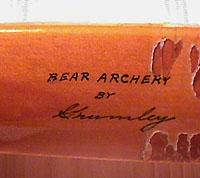

Beginning in 1938, Grumley bows bore the stamped mark of
the maker, sometime in the early 1940’s, the stamp was broken
and all bows after that date bore the written mark of their famous
maker.
Why the different means of signing the bows? Well, when Nels
first began making bows for Fred in 1938, he used a sort of branding
iron to stamp into the wood his mark "Bear Products by Grumley".
Then somewhere in the early 1940’s, the brand was dropped
and broken and instead of buying a new one Nels simply began
writing his name on the bows.
Note: Remember that the company was known as Bear Products
until 1940, so the "Bear Products by Grumley" bows
were obviously made before those marked "Bear Archery by
Grumley".
Nels left Bear in 1948 when Fred made the decision to begin
mass production of bows at the new factory in Grayling. Nels
felt strongly that bows should be individually crafted, and not
made by machine. So Nels left, even though Fred tried to convince
him to stay with some handsome financial offers, and struck out
on his own to make bows. However, his private venture into the
bow making business lasted only two years before he took a job
in an appliance manufacturer as a model maker. These "Grumley
by Grumley" bows are marked with a simple stamped signature
"Grumley" either on the limb or on the riser, and are
very scarce and excellent collector items.
Not all Bear bows made in these early years were made by Nels.
There were dozens of other bowyers who made Bear wooden bows,
mostly the lower line lemonwood models such as the Ranger. These
bows were simply marked "Bear Archery" in a written
form. However, in late 1948 Bear began using what later became
known as the small "Running Bear" decal, and thus some
bows built beginning in 1948 may have this decal instead of the
written brand.
Models of Grumley bows
Nels made 4 basic styles of bows:
These bows were available primarily in one piece design ,
but a few were made in 2 piece take-apart and some in 2 piece
hinged models. The later Grumleys also can be found in laminated
woods as well as self-wood models. Additionally you will find
Grumley’s backed with sinew, rawhide, and various types
of wood. A characteristic of Grumley bows is the trapezoidal
limb cross section. By this I mean that the face of the limb
is wider and tapers down towards the back of the limb giving
a cross-sectional view which appears as a trapezoid.
Remember also that Bear would take special orders for bows
during this time period, and the above models are only the "stock"
models. Many one-of-a-kind Grumleys exist in collections that
represent the buyers wishes expressed by Nels Grumley’s
hands.
But whatever the model,and whatever the wood or backing, the
quality of the craftsmanship was simply unparalleled. Of the
bows which I have seen over the years, the only bowyer who I
would put in the same class as Grumley would be James D. Easton
of California.

The Grumley bow on the left is a Bush Bow, while the bow
on the right is the Deerslayer model. Notice the different length
of the brush nocks.
The Grayling Era bows of Bear Archery
Beginning in 1947, Bear Archery moved into a new plant in
Grayling, Michigan. Bow sales were now beginning to soar as new
archers and bowhunters entered the sport in record numbers due
in large part to the successful promotions of Fred Bear.
Fred realized that he could not meet the demand which would
come from these new recruits by making bows one at a time like
Bear had been doing since it's inception almost 15 years earlier.
So he came up with a new method of mass producing bows, finally
allowing his company to meet this demand. But Nels Grumley would
not accept that quality bows could be made by any other manner
than one-at-a-time, so Nels left the company to go out on his
own.
Upon Nels departure, Fred moved another employee by the name
of Bob Meeker over to supervise the manufacturing of the new
bow lines. Even though bows were then largely the result of machine
work, Bob came to be considered a fine bowyer in his own right.
The Aluminum Laminated Bows
The first new bow model which was introduced in 1949 after
Nels’ departure was the Grizzly. The Polar and Kodiak were
introduced in the following year, 1950.
These bows of 1949, 1950 and early 1951 can be recognized
by the lamination of aluminum in the limbs. This aluminum was
scrapped from B-17 bomber airplanes of WWII, the purchase of
which was arranged from the government by Glen St. Charles. The
aluminum lamination on the Kodiak and Grizzly is found only in
the inner lamination, surrounded by layers of maple and glass.
However, on the Polar, the aluminum is found both under a layer
of maple and glass, and on the outside lamination.
In 1949 and 1950 Bear was using a bi-directional glass on
their bows which looks somewhat like a basket weave pattern.
Then in 1951 Bear began using a new Uni-Directional glass in
which the glass fibers all ran lengthwise to the bow limbs. This
is a good way to tell the difference between the 1949/50 and
the 1951 models. The 1951 Grizzly also began production with
the aluminum lamination, but very early in 1951 the aluminum
was dropped due to the high reported breakage problems of these
aluminum bows.
The Kodiak was introduced in 1950 with the bi-directional
glass and the aluminum lamination. Then in early 1951, just as
with the Grizzly, the new uni-directional glass was introduced
but the aluminum lamination was still present. This glass change
apparently occurred around serial number 5000. Then in mid-1951,
the aluminum lamination was dropped. So for 1951 you will find
Kodiaks with aluminum and bi-directional glass, aluminum with
uni-directional glass, and no-aluminum with uni-directional glass.
This aluminum laminated caused two problems. First, the bows
had quite a bit of handshock when shot, and as a result were
not comfortable to shoot. Secondly, the large amount of shock
contributed to a large number of bows delaminating. This warranty
problem caused a substantial strain on the companies finances,
but Fred insisted that all bows be replaced if returned broken.
The Compass Kodiaks
Another popular bow for collectors of Grayling manufactured
bows is the Kodiak II of 1954. Also known as the Compass Kodiak
because of the small, round compass embedded into the riser section,
this bow was another good idea which almost caused the company
to go under. The compass required a significant amount of wood
to be removed from the riser in order to be inlaid, and as a
result caused the riser sections on many of these bows to fail.
Again, Fred insisted that the warranty on these bows be honored
and all returns were replaced with another bow.
The Kodiak II’s of 1954 were made using two different
woods for the riser, maple and walnut. If the riser section of
your K-II is very dark, then you have a walnut model. Conversely,
if the riser of your K-II is a light colored wood, then you have
a maple model. The walnut bows were made only for the first 2-3
months of 1954, before being replaced by maple in mid-year.
There were also many different lengths available in each of
the different kinds of wood. But all K-II’s are very collectible
and highly sought after bows. don't shoot a Compass Kodiak! The
structural strength of this design was the main reason for it's
discontinuance, and many years later the bows that survive are
too valuable as collectors items to risk breaking another.
The Bear Take-Down
Fred had been tinkering with take-apart and take-down bows
of different styles for 30 years when in the mid-1960’s
he began working on a new design that would require no tools
for assembling/disassembling the limb and riser sections. Finally,
in August 1969 the famous Bear Take-Down recurve went into production.
Note - Although introduced in August 1969, the Take
Down model bow did not appear in the Bear catalogs until 1970.
This new model bow was manufactured in 3 different riser lengths,
which were known as the "A", "B", and "C"
risers. The "A" riser was the shortest, and the "C"
the longest, with the "B" being in the middle. In this
manner, the archer could mix and match riser styles with various
length limbs to allow the bowhunter to pick the bow which best
fit his or her desires.
Note - Although officially discontinued in 1972, several
parts for these bows remained on the shelves at Bear, and a few
"A" and "B" models were assembled in 1973
and 1974. These later assemblies can be recognized by their white
serial numbers.
How many Bear Take-Downs were actually made? In the three
years of production, there were 400 "A" models made,
800 "B" models made, and only 300 "C" models.
Then why is the "C" the least valuable of the lot even
though it is actually the rarest of the Take-Downs? Apparently
this is because it is thought of as a target bow rather than
a hunting bow by collectors.
Some collectors place significance on the year of the manufacture
of the take-down relative to the value of the bow. Actually,
more than year, the collector should be referring to Type. The
first models made in 1969/1970, up through serial number 2000,
are referred to as Type I’s. Models made in 1971 and later
are correctly referred to as Type II’s, due to a change
in the riser style.
Note - The serial numbers of all the Take-Downs begin
with a letter which designates the riser style. For example,
and "A" handle will have a serial number which begins
with an "A", a "B" handle will have a serial
number which begins with a "B", etc.
There is some greater value attached to the Type I bows by
some collectors because these "improvements" of the
Type II models actually caused some weaknesses in the bow riser’s
strength.
Note - An option from the factory on the Bear Take-Down
was the Bear Premier Hunting sight, only listed in the catalog
for the "B" handles, and for the second and third years
of production. This sight was factory installed in the sight
window of the bow.
The Bear Take-Down could be ordered in one of three different
limb lengths. Known as Limb Style Number 1, Style Number 2, and
Style Number 3. The #1 limbs were known as the Short Limbs, the
#2 as the Medium Limbs, and the #3 as the Long Limbs. Matching
these various limbs with the different risers allowed the buyer
to choose a bow length all the way from 56" to 70".
These limbs can be found with both a white overlay in the limb
tip, and with a red overlay. The white overlays were made before
the change to the red overlays.
How To Date Bear Bows
A very common question from beginning Bear bow collectors
is how to determine the age of a bow. There are many features
and changes applied by Bear over the years which will help you
in determining your bows model year.
Note - A great deal of the credit for the following
information is due to Mr. Al Reader of North Haledon, New Jersey.
Al has studied Bear Archery for many, many years and is considered
by everyone as the King of Information regarding Bear Archery
collecting.
First, if your bow is all wood, meaning that there is no laminations
of any kind, then your bow had to be made before the mass production
beginning in 1949. If your all wood bow has a stamp which says
"Bear Products" in some form, then it had to be before
the early-mid forties. If your all-wood bow says "Bear Archery",
then it had to be manufactured after the early-mid forties and
before 1949. Wooden bows with a small "Running Bear"
decal can be dated to 1948.
Another way is to look for a leather grip. All Bear bows had
leather grips from those first Grumley’s in the late 30’s
until 1959. In 1959, the Kodiak Special dropped the leather grip,
and in 1961 the Kodiak followed suit. The Grizzly kept the leather
grip until 1964.
Yet another way to help determine the age of your bow is to
look for a coin type medallion in the riser. Beginning in 1959,
all Bear bows had a coin medallion of one type or another. The
coin was copper in 1959, then changed to Aluminum in 1960-61,
and Pewter in 1962. Brass coins were used in 1963-1970, and nickel-silver
in 1971-72. The coins were all flush with the wood until 1972.
Then in late 1972 it was raised above the surface of the bow.
These raised medallions came in both gold and chrome covered
plastic and are still used in todays Bear bows.
Note - Using the medallions for dating bows is not an
absolute rule with Bear bows, as sometimes the plant would just
throw medallions in a bin and the bow maker would reach in and
grab medallions which may have been from a year or two earlier.
Place of Manufacture
In 1978, a strike at the Bear plant in Grayling, MI forced
a move of all manufacturing and offices to Gainesville, Florida.
If your bow says Gainesville on it, then you know that it was
made after this move.
The 1953 Patent Date
All Bear bows from 1953 until 1972 have the "1953 Canadian
Patent" date on them. This patent covered the working recurve
limb. This is the date of the patent only, and does nothing to
date the bow itself.
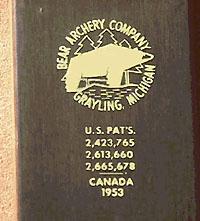
The 1953 Patent date which appears on all Bear bows from
1953 until 1972 is simply the date of the patent for a working
recurve limb and has nothing to do with the actual model year.
The Decals and Silkscreening
The small Running Bear decal was first used in 1948, and was
replaced by the large Standing Bear decal in mid-1953. The large
Standing Bear decal also had the words "Glass Powered"
under the Standing Bear.
The large Standing Bear decal was used until 1955 when it was
replaced with the improved methods of silk-screening the identification
on the bows. The silk-screening appeared on all bows by the 1956
model year.
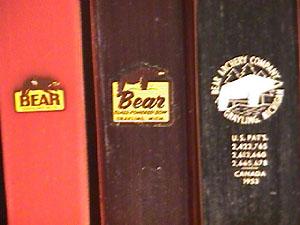 The small Running Bear decal on the left was used
by Bear from 1948 until 1953, with the larger Standing Bear decal
replacing it in mid-1953 and lasting until the 1955-56 model
years. Beginning in 1955-56 Bear began using the silk-screened
logo shown on the far right.
The small Running Bear decal on the left was used
by Bear from 1948 until 1953, with the larger Standing Bear decal
replacing it in mid-1953 and lasting until the 1955-56 model
years. Beginning in 1955-56 Bear began using the silk-screened
logo shown on the far right.
How About Serial Numbers for Dating?
According to research done by Al Reader of New Jersey, who
by the way is considered by most to be the most knowledgeable
Bear collector alive, serial numbers work very well for dating
Bear bows, but only for the years 1965-1969 when the first digit
of the serial number is the year of manufacture. For example,
a serial number of 6Z3884 would be a 1966 bow. Prior to 1965,
the serial numbers for all Bear bows were started over every
month, making these bows almost impossible to date by serial
number alone. The "K" series of serial numbers (for
example KZ9399) were started in 1970.
Even looking at the catalogs is not a sure way of dating a
Bear bow, as sometimes the pictures were used for more than one
year, even though there might have been changes in the woods
used, or the colors available.
Remember also that Bear had to take the next yearns catalog
to the printer in late fall of the prior year. This means that
bows for that catalog or model year had to be available to take
pictures of in the fall before the catalog was printed. For this
reason, you will find bows of a particular year with features
of the previous year. A good example would be the few known examples
of the 1954 Kodiak II (Compass Kodiaks) with the small "Running
Bear" decal which was actually discontinued in late1953.
Most 1954 Kodiak II’s will be found with the large Standing
Bear decal which replaced the small Running Bear decal in 1954.
Another example would be the few known 1959 Kodiaks which don't
have a coin medallion which were supposed to be on all Kodiaks
beginning in model year 1959. Obviously these bows were made
in late 1958 before the medallions became available to the factory.
Sometimes showing the bow to a knowledgeable collector is
the only sure way to get an accurate date of manufacture.
Yearly Production Chart For The Most Popular
Grayling-Made Bear Bows
(Researched by and reprinted with the permission
of Al Reader, North Haledon, NJ)
Wood Handle Take-Down 1969-1972
Wood C-Riser Victor Custom 1973-1975
Magnesium Handle Take-Down A-B-C 1971-1978
Kodiak Static Recurve 1950-1953
Kodiak Recurve 1954-1966
Super Kodiak 1967-1976
Grizzly Static Recurve 1949-1957
Grizzly Recurve 1958-1978
Super Magnum 48 1966-1976
Kodiak Magnum 52" 1961-1977
Kodiak Hunter 58" and 60" 1967-1977
Tamerlane 1962-1968
Tamerlane HC-30 1965-1967
Tamerlane HC-300 1968-1972
Kodiak Special 1955-1967
Temujin 1968-1970
Tarter 1968-1972
Victor Patriot 1973-1977
Victor 1972
Polar (recurve) 1957-1970
Alaskan (leather grip semi-recurve) 1959-1961
Alaskan (recurve) 1966-1970
Tigercat 1964-1978
Bearcat 1964-1971
Black Bear 1972-1978
Little Bear 1965-1978
Broadheads - The Bear Razorhead
If there were some way to measure the most successful broadhead
of all time, I would put my money on the Bear Razorhead, with
the Zwickey a very close second.
Fred Bear was always the inventor, the tinkerer. In the 1930’s,
Fred was making his personal broadheads from flat steel, in the
style of tie-on heads modeled after the trade points of the wild
west days. But these were very tedious to make and to attach
correctly to the arrow. And certainly there was no way to mass-market
such a head to the public.
Fred was very good at recognizing a market need, and soon
started slotting Zwickey broadheads and adding removable bleeder
blades in an attempt to discover a better broadhead which could
be mass produced and marketed to the growing ranks of bowhunters
of the day. The bleeders which were used in these slotted Zwickeys
were very large compared to the bleeders that we see in todays
broadheads, but the idea worked and encouraged Fred to continue
with his experiments.

There were at least 2 different styles of "Airplane-Wing"
bleeders used in the slotted Zwickeys of the days prior to the
Razorhead.
In 1952 Fred began tinkering with a glue-on ferrule design
for broadheads. These first heads were one of a kinds, but he
was nearing completion of a design that would be both good for
hunting and mass marketing.
By 1955, Fred was confident enough of his design that he made
300 prototypes of a new "Razorhead" design broadhead,
and sent out samples to many of his bowhunting colleagues across
the country asking them to try out this new head. If reports
were positive, he planned to begin mass-production of them within
the next year for the general public.
This prototype model Razorhead became known as the "Pinned
Bear" due to the appearance of a "Pin-like" depression
at the end of the ferrule. Actually, this was not a true pin,
but rather a punch impression which held the blade to the ferrule
better. Of the 300 prototypes which were originally made, only
a very few survived to be in collections today. Apparently Fred’s
bowhunting friends took him to his word and went out and shot
them as he had asked, eventually loosing them in the swamps and
forests across the country.
Note: Be on the lookout for these pinned models, and
if you find one you have found a gold-mine as broadheads go.


Here is a picture of the various styles of Razorheads over
the years. From left, the Pinned Ferrule, the 1956 Bubble-Head,
the 1959. The photo on the right is another 1959, the 1960, the
1964. Notice the difference in the ferrule ends, and the vents
among the different years.
In 1956, Bear Archery formally introduced the Razorhead to
the public. Known today as the "Bubble-Head" by many
collectors because of the rounded ferrule tip, this broadhead
was an instant success. Good quality steel, easily sharpened
and aligned to the arrow, the Razorhead was on it's way to becoming
the largest selling broadhead of all time.
But Fred found a small problem with this original design.
The "Bubble" on the tip of the ferrule was affecting
penetration. So in 1959, Bear began flattening the ferrule tip
to improve this situation. However, the vents on the 1959 Razorhead
remained large as with the original 1956 model.
In 1960, a new die was made, with the vents made smaller and
the ferrule tip even flatter. Lastly, in 1964, the vents were
changed again, looking much like a die-cut parabolic feather
shape now.
The Super Razorhead was introduced in 1978, and the era of
the old lime-green Razorhead came to a close. However, these
new Super Razorheads did not have a reputation for holding up
under use and lost favor with the masses of bowhunters in time.
However, Bear Archery’s ability to market better than anyone
else kept this broadhead in tackle boxes.
Finally, in 1981, the Stainless steel version of the Razorhead
came out, but it is the old lime-green Razorheads that remain
popular with bowhunters today both as collectors, and as shooters.
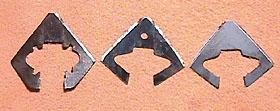
The auxiliary bleeder blade on the pinned ferrule Razorheads
had the impression of a bear head in the vents, complete with
ears and all as seen in this picture. The bleeder on the first
production Razorhead in 1956 had the small pin hole in it, as
shown. The bleeders soon changed to look like the bleeder on
the right for all production after that. Be on the look out for
these different bleeder blades!!
Note- Among the rarest of all broadheads is the Bear
"Giant". Made in 1959 as an experimental head, Fred
used these heads on his trip to Alaska that year. However, problems
with the inch-and-a-half main blade caused poor arrow flight
which kept these heads from ever going into production and today
only 2 are known to exist in collections across the world.
Books by Fred Bear
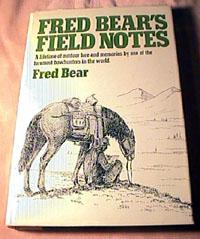
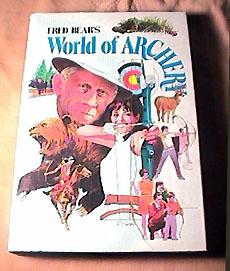

From left to right: The Archer’s Bible (1968), Fred
Bear’s Field Notes (1976), and Fred Bear’s World of
Archery (1979).
Fred wrote or played a major role in three books during his
lifetime. The first was The Archer’s Bible in 1968.
Many thousands of copies of this book were sold for many years
after it's introduction. This book can still be found in used
book stores and from book search services fairly easily. The
value of this book has remained fairly constant at the $8-10
range.
The next book which credits Fred as the author would be the
classic "Fred Bear’s Field Notes", first
published in 1976. Page for page, this book has my money for
being one of the best adventure books of all time. This book
can still be found in first edition in used book stores and Internet
book services to this day, although prices are starting to climb
quickly. An average price for a good first edition of this book
would range from $35-50 with a good dust jacket.
Note: In the past year, I have bought 3 autographed
copies of Field Notes from the internet for no more than $35
each!!! What a bargain. Keep your eyes open. Go back and read
my earlier column on Book Collecting for tips on how to find
used books on the Internet. But Remember, if I don't have it,
I saw it first!!!
The last book for which Fred can be listed as the author was
"Fred Bear’s World of Archery", published
in 1979. Intended to be an all-around information book about
the sport which consumed his entire adult life, the first edition
of this book can still be found on the shelves of used book dealers,
and later editions can still be found in new retail stores. A
good first edition would average around $25-35 on the used market.
Bear Archery Company Catalogs
In the Beginning
The first Bear Archery Catalogs were no more than folded pamphlets
advertising the leather goods which Fred had begun making in
a shop in downtown Detroit. These first brochures were apparently
produced in 1935. I say this because an add was found in the
March 9, 1935 issue of Archery Review which announces
that the Bear Products Company has a brochure available which
can be obtained by writing the company on Tireman Avenue in Detroit.
Although I have not actually seen a copy of this brochure, and
I know of no one who has one in their collection, there were
surely no bows in this catalog since Bear was making only accessories
at this point in time.
The next piece of ephemera from Bear came in 1938 with the
issue of a true catalog which details all their leather products
and other accessories, but again no bows. Finally, in 1939, a
24 page catalog was issued from Bear Products which listed the
first Bear bows.
These catalogs and brochures with the name Bear Products Company
on them are very, very scarce.
Note - The Bear Archery catalogs of 1975 were unique
in that they were printed in 4 different language versions -
French, German, Japanese, and English.

The early Bear Archery catalogs were not dated, but numbered.
From left to right are the #23, 24, 24A, and 25. I am missing
the #20.
The Rarest of the Bear Catalogs?
The title of rarest Bear Archery Company catalog (not counting
the early Bear Products brochures) would belong to the 1957,
followed fairly closely by the Catalog #20. Why 1957? Something
happened at the printer that year which destroyed the catalogs
before many had been delivered to Bear. In an effort to get catalogs
into the hands of their customers, Bear actually glued covers
from 1957 onto catalogs of 1956!!!.
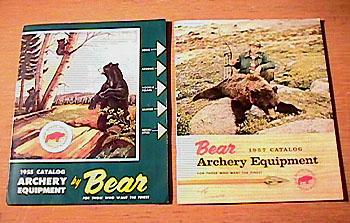
The 1955 catalog is shown on the left, with the rare
1957 pictured on the right in this photo.
Note – Be on the lookout for 1957 catalogs which
are actually 1956 catalogs with the 1957 cover glued on!! This
happened in the Bear factory due to the loss of most all of the
true 1957 catalogs. The true 1957 is the one that you are after,
although neither is common by any stretch!!
Do people actually collect the catalogs? With a fever pitch
do they collect them!! The catalogs prior to the 1970’s
are becoming very hard to find, and the early 60’s and the
dated ones from the 50’s could even be considered scarce.
The numbered ones might go so far as to be labeled rare in some
collector’s opinions. As for value, I don't dare risk putting
my opinion here, cause sure as I did I would be proven wrong
the next time someone sold one. It truly is a sellers market
in Bear catalogs.
Catalogs of the Bear Products Company
1935 Tireman Avenue, Detroit, Michigan. Leather Products and
Accessories only.
1938 4700 Burlingame, Detroit, again only accessories are
listed
1939 4700 Burlingame, Detroit, with bows appearing for the
first time in a Bear catalog, 24 pages
1940 Catalog #40A, 2611 W. Philladelphia St., Detroit
1940? Fold Out flyer #HP1 4-40 Accessories only 2611 W. Philadelphia,
Detroit.
Catalogs of the Bear Archery Company
1942 Catalog #10-42 Leather products only. 2611 W. Philadelphia,
Detroit.
1942 Catalog #11-42 Bows and other products . 2611 W. Philadelphia,
Detroit
1944 Catalog #10-44 Leather products only. 2611 W. Philadelphia,
Detroit
1947 Catalog #20 Complete catalog Grayling, Michigan
1949-50 Catalog #23
1951-52 Catalog #24 Complete catalog Grayling, Michigan
1953 Catalog #24A Complete catalog Grayling, Michigan
1954 Catalog #25 Complete catalog Grayling, Michigan
1955 - Present are all dated
Note - In 1967, there was a 1967 ½ catalog published
to announce the new "Super Kodiak" and the Kodiak Hunter
model bows.
Other Items of Interest From Bear Archery
Knife, Stone, and File Set
Although not listed in the Bear catalog until 1957 for the
first time, the Knife, Stone, and File set was being made as
early as 1951 according to Al Reader. Officially called the Bowhunter’s
Kit, there were 25 units made and given to friends by Bear in
those years before they were first found in the catalog.
A simple Western knife, with a sharpening stone and file all
in one leather sheath and selling for only $9.95, this popular
item remained in the catalog all the way until 1978. Then why
are they so hard to find? Good question, but I would venture
a guess that most were lost to time in the bottom of a bowhunter’s
tackle box, and may still be there waiting to be discovered.
Get out your old Bear catalogs from 1957 through 1978 and find
the picture of this scarce item, then you will know what to look
for. I am sure that they are out there in the flea markets waiting
for you to find them. And if you find two, call me!
Note - To tell if the knife in a set is the right knife,
look at the model number found on either the tang or the finger
guard. The model number should be #648. If it is not a #648,
then the knife is not original.
The scabbards on the first 25 sets which were produced beginning
in 1951 probably did not have a logo or brand mark on them at
all, while the scabbard had the small Running Bear
logo from the first sets in 1957 until somewhere in the mid-1960’s.
Then in this mid 1960’s time frame, the logo was dropped
in favor of the Bear script lettering which remained until the
item was discontinued in 1978.
The early Bowhunter Kits had a Western knife with real bone
handle, and the. Somewhere around the time of the logo change
on the scabbard, the knife handle also changed over to a synthetic
handle called Derylin.
Note - I have seen these items sell for as much as $250
each. Can this be a realistic price for an item which was made
for over 25 years? Not in my humble opinion. I would bet that
if the collector would get creative about where to look for this
item, it could be found for a much more reasonable price.
St. Charles Quiver
Glen St. Charles was the West Coast distributor for Bear Archery
almost since the beginning. It was Glen who set up the famous
Little Delta hunts in Alaska during the late 1950’s, and
it was Glen who designed the famous St. Charles quiver. First
found in the 1961 Bear Catalog, the first model St. Charles quiver
was available only in a suede leather at a cost of $12.50. These
first model quivers in suede are very scarce.
Note - There were actually two different variations
of the first model suede St. Charles quiver. The first variation
from 1961 until 1963 had no chest strap, with the chest strap
being added for the 1964 year and for all models thereafter.
The second model St. Charles quiver was available in "antique
elk hide" (a smooth leather) beginning in 1965, and the
last model was available in vinyl beginning in 1971.
The St. Charles quiver was discontinued after the 1974 catalog.

This is a photo of the second variety of the St. Charles
Quiver, with antique elk hide construction. Notice that the leather
is smooth as compared to the first model which was offered in
suede.
Both of the leather models command a lot of attention with
todays collectors, while the vinyl model is only moderately desirable.
Fred Bear’s "Secrets of Hunting"
Album and Cassette
This limited edition LP record album was first made available
in 1968, but not officially listed in the catalog until 1969.
Recorded with Curt Gowdy of Sportscaster fame, Fred relates many
stories of his hunts and tips for success. Sold for $1.00 in
the catalog, this item only lasted until 1970, when it was discontinued.
During this time over 60,000 records were sold. Prices for this
album have soared recently, as I have seen auctions bringing
up to $30-50 each for a good copy.
Note - Is $50 realistic for an item with relatively
large production runs? In my opinion, this item has gotten out
of control and needs to come back to earth in value.
In 1983 Bear re-introduced the "Secrets of Hunting"
as a cassette. This version lasted through 1986. I have not seen
a cassette sell or trade on the secondary market lately, so value
is really undetermined, but as I said before if it says Bear
Archery on it be sure that someone, somewhere wants it bad.
Early Bow Quivers
Fred Bear patented the original bow quiver in 1946. This first
model bow quiver has come to be known as the "Scabbard Quiver"
due to it's all leather appearance, except for the base where
the arrow clips are mounted. This original quiver, made of soft
sheepskin, was available only in a 3 arrow model, was made from
1946 through 1956.
The famous "leather top" quiver, recognized by the
brown metal frame and hood with leather cap, became available
in 1956 in the screw-on and a tape-on variety.. The spring-arm
variety was not available until 1963. These models were all 4
arrow design and were last listed in the catalog in 1971.
The 8-arrow quiver from Bear Archery was introduced in 1963.

From left to right, the first model Bear Quiver from 1946,
the screw-on leather top quiver first introduced in 1956, and
the spring arm leather top quiver not introduced until 1963.
Chronology of Events for Bear Archery Company

